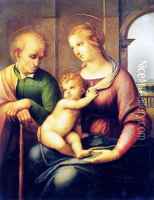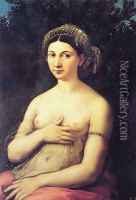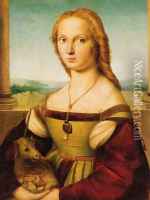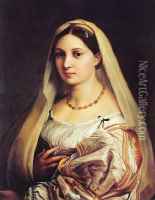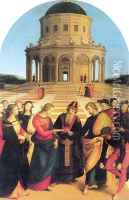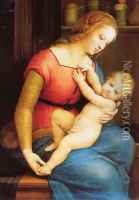Raffaelo Sanzio Paintings
Raffaello Sanzio, known as Raphael, was an Italian painter and architect of the High Renaissance. Born on April 6, 1483, in Urbino, Italy, Raphael was blessed with a serene and harmonious style that was characteristic of the Renaissance's classical ideals. His father, Giovanni Santi, was a court painter to the Duke of Urbino, and he introduced Raphael to the world of art at a young age.
Raphael's early work reflects the influence of his teacher, the Umbrian master Pietro Perugino. However, Raphael soon developed his own distinct style, characterized by clarity of form and ease of composition. In his early twenties, he moved to Florence, where he was exposed to the work of contemporary Renaissance masters such as Leonardo da Vinci and Michelangelo. These experiences further shaped his artistic evolution.
In 1508, Raphael was summoned to Rome by Pope Julius II and was commissioned to decorate the papal apartments, including the Stanza della Segnatura. Here he painted some of his most famous frescoes, including 'The School of Athens,' which represents the pinnacle of Renaissance ideals of classical beauty and harmony.
Apart from his large-scale frescoes, Raphael was also a prolific painter of altarpieces, portraits, and mythological subjects. His 'Sistine Madonna' and 'The Transfiguration' are among his celebrated masterpieces. Raphael's portraiture is also highly regarded, with the 'Portrait of Baldassare Castiglione' and 'La Donna Velata' exemplifying his ability to capture the subtle nuances of personality and expression.
Raphael's architectural contributions include the design of the Chigi Chapel in the Church of Santa Maria del Popolo and the extension of the Palazzo Branconio dell'Aquila in Vatican City. His design principles would influence the architectural style of the late Renaissance and Baroque periods.
Raphael died on April 6, 1520, his 37th birthday, in Rome. His untimely death was mourned throughout Italy, as he was celebrated for his artistic genius and his kind and generous nature. Raphael's work marked the high point of Renaissance art, and his influence persisted through the ensuing centuries, affecting artists and art connoisseurs alike. Today, Raphael is remembered as one of the trinity of great masters of the Renaissance, alongside Leonardo da Vinci and Michelangelo.







